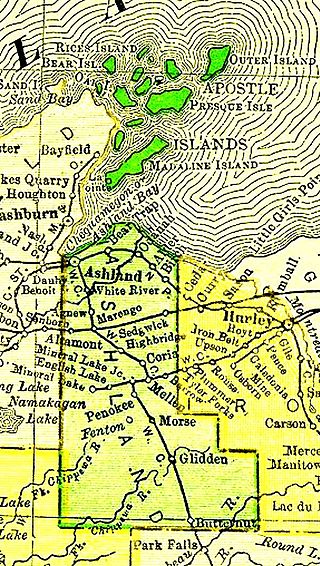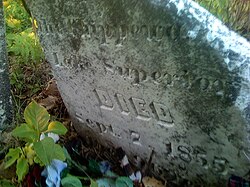
Mackinac Island is an island and resort area, covering 4.35 square miles (11.3 km2) in land area, in the U.S. state of Michigan. The name of the island in Odawa is Michilimackinac and "Mitchimakinak" in Ojibwemowin, meaning "Great Turtle". It is located in Lake Huron, at the eastern end of the Straits of Mackinac, between the state's Upper and Lower Peninsulas. The island was long home to an Odawa settlement and previous indigenous cultures before European colonization began in the 17th century. It was a strategic center of the fur trade around the Great Lakes. Based on a former trading post, Fort Mackinac was constructed on the island by the British during the American Revolutionary War. It was the site of two battles during the War of 1812 before the northern border was settled and the US gained this island in its territory.

La Pointe is an unincorporated community in the town of La Pointe, Ashland County, Wisconsin, United States. It is on the western shore of Madeline Island, the largest of the Apostle Islands. Downtown La Pointe is adjacent to the Madeline Island Ferry dock. La Pointe has a post office with ZIP code 54850.

Fort Michilimackinac was an 18th-century French, and later British, fort and trading post at the Straits of Mackinac; it was built on the northern tip of the lower peninsula of the present-day state of Michigan in the United States. Built around 1715, and abandoned in 1783, it was located along the Straits, which connect Lake Huron and Lake Michigan of the Great Lakes of North America.

Irenaeus Frederic Baraga was a Slovenian Roman Catholic missionary to the United States and a grammarian by and author of Christian poetry and hymns in Native American languages. He became the first bishop of the Roman Catholic Diocese of Marquette, Michigan, originally sited at Sault Sainte Marie, which he led for 15 years.

The Apostle Islands are a group of 22 islands in Lake Superior, off the Bayfield Peninsula in northern Wisconsin. The majority of the islands are located in Ashland County—only Sand, York, Eagle, and Raspberry Islands are located in Bayfield County. All the islands except for Madeline Island are part of the Apostle Islands National Lakeshore. The islands in Ashland County are all in the Town of La Pointe, except for Long Island, which is in the Town of Sanborn, while those in Bayfield County are in the Towns of Russell and Bayfield.

The Bad River LaPointe Band of the Lake Superior Tribe of Chippewa Indians or Bad River Tribe for short are a federally recognized tribe of Ojibwe people. The tribe had 6,945 members as of 2010. The Bad River Reservation is located on the south shore of Lake Superior and has a land area of about 193.11 square miles (500.15 km2) in northern Wisconsin, straddling Ashland and Iron counties. Odanah, the administrative and cultural center, is located five miles (8.0 km) east of the town of Ashland on U.S. Highway 2. The reservation population was 1,545 in 2020. Most of the reservation is managed as undeveloped forest and wetland, providing a habitat for wild rice and other natural resources.

Chequamegon Bay is an inlet of Lake Superior in Ashland and Bayfield counties in the extreme northern part of Wisconsin.

Red Cliff Band of Lake Superior Chippewa is a band of Ojibwe Native Americans. The Red Cliff Band is located on the Red Cliff Indian Reservation, on Lake Superior in Bayfield County, Wisconsin. Red Cliff, Wisconsin, is the administrative center. Red Cliff is notable for being the band closest to the spiritual center of the Ojibwe nation, Madeline Island. As of November 2010, there were 5,312 enrolled members, with about half living on the reservation and the rest living in the city of Bayfield or the Belanger Settlement.

Madeline Island Museum is a museum owned and operated by the Wisconsin Historical Society. Opened on June 15, 1958, the museum is in the town of La Pointe, Wisconsin on Madeline Island, one of the Apostle Islands in Lake Superior. Madeline Island Museum was developed on the former site of the American Fur Company Northern Outfit, and its main building once served as an American Fur Company warehouse. The museum can be reached by boat or by the Madeline Island Ferry.

Madeline Island is an island in Lake Superior. Located in Ashland County, Wisconsin, it has long been a spiritual center of the Lake Superior Chippewa. Although the largest of the Apostle Islands, it is not included in the Apostle Islands National Lakeshore. It is the only island in the Apostle Island chain open to commercial development and private ownership.

Chief Buffalo was a major Ojibwa leader, born at La Pointe in Lake Superior's Apostle Islands, in what is now northern Wisconsin, USA.

Francis Xavier Pierz was a Slovenian-American Roman Catholic priest and missionary to the Ottawa and Ojibwe Indians in present-day Michigan, Wisconsin, Ontario, and Minnesota. Because his letters convinced numerous Catholic German Americans to settle in Central Minnesota after the Treaty of Traverse des Sioux in 1851, Fr. Pierz is referred to as the "Father of the Diocese of Saint Cloud."

Zeba is an unincorporated community and census-designated place (CDP) in Baraga County in the U.S. state of Michigan. The CDP had a population of 397 at the 2020 census. The community is located near the southern end of the Keweenaw Bay just north of the village of L'Anse within L'Anse Township.
The Lake Superior Chippewa are a large number of Ojibwe (Anishinaabe) bands living around Lake Superior; this territory is considered part of northern Michigan, Wisconsin, and Minnesota in the United States. They migrated into the area by the seventeenth century, encroaching on the Eastern Dakota people who had historically occupied the area. The Ojibwe defeated the Eastern Dakota, who migrated west into the Great Plains after the final battle in 1745. While they share a common culture including the Anishinaabe language, this highly decentralized group of Ojibwe includes at least twelve independent bands in the region.
The Tragedy of the Siskiwit was an event that took place in the pre-contact history of the Ojibwe and Meskwaki (Fox) Indian nations in present-day Wisconsin. As part of an ongoing series of conflicts between the two nations, a chief's son was kidnapped, and both groups had their camps destroyed.

Magdelaine La Framboise (1780–1846), born Marguerite-Magdelaine Marcot, was one of the most successful fur traders in the Northwest Territory of the United States, in the area of present-day western Michigan. Of mixed Odawa and French descent, she was fluent in the Odawa, French, English and Ojibwe languages of the region, and partnered with her husband. After he was murdered in 1806, she successfully managed her fur trade business for more than a decade, even against the competition of John Jacob Astor. After retiring from the trade, she built a fine home on Mackinac Island.
Michel Cadotte, Kechemeshane in Ojibwe was a Métis fur trader of Ojibwe and French-Canadian descent. He dominated the business in the area of the south shore of Lake Superior.

William Whipple Warren was a historian, interpreter, and legislator in the Minnesota Territory. The son of Lyman Marcus Warren, an American fur trader and Mary Cadotte, the Ojibwe-Metis daughter of fur trader Michel Cadotte, he was of Ojibwe and French descent. William lived in two cultures, because his father was white, he was not considered Ojibwe, but an Ojibwe "relative", because in the Ojibwe patrilineal culture, inheritance and property were passed through the paternal line. His mother was Ojibwe and he learned her culture from her family. He is the first historian of the Ojibwe people in the European tradition.

Tolomato Cemetery is a Catholic cemetery located on Cordova Street in St. Augustine, Florida. The cemetery was the former site of "Tolomato", a village of Guale Indian converts to Christianity and the Franciscan friars who ministered to them. The site of the village and Franciscan mission is noted on a 1737 map of St. Augustine. A cemetery for the inhabitants of the village was also located on the grounds, with a portion of this cemetery set aside for former American black slaves, who had converted to Catholicism after escaping bondage in the Carolinas.

The Old Protestant Cemetery, also known as Northam Road Cemetery, is a disused Protestant cemetery in George Town, Penang, Malaysia. After more than a century of neglect, it is now listed as a Class 1 Heritage Site and is maintained by the Penang Heritage Trust.




















